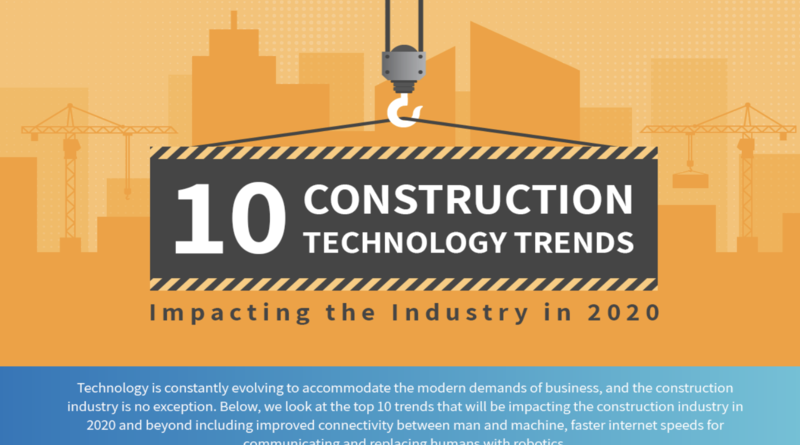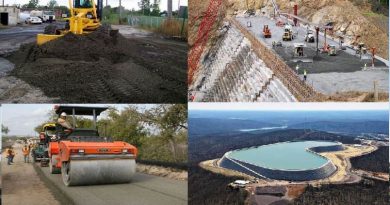10 Construction Technology Trends Impacting the Industry in 2020
The digital landscape is changing at an ever-increasing speed. The question for organisations is no longer if they are going to digitalise their workspace, but when and how are they going to keep up with Construction Technology and adapt with ever evolving technologies.
In this article we take a look at ten crucial construction technology trends that are impacting the industry in 2020.

1) Big Data
A century ago, the resource in question was oil. Today the giants of the digital industry deal in data, the oil of the digital era.
There are 2.5 quintillion bytes of data created each day at our current pace, but that pace is only accelerating as construction technology advances. Over the last two years alone a mind-blowing 90 percent of data in the world was generated!
“The world’s most valuable resource is no longer oil, but data.”
What is big data and where is the data coming from?
Big data is a term used to describe extremely large data sets that may be used to uncover hidden trends, patterns in behaviour, unknown correlations to make more informed business decisions and serve as the basis for artificial intelligence and automation systems. It is this big data that helps evolve advancements in construction technology.
This data is being gathered from Internet searches and services, mobile phones, digital photographs, social media and many other forms of digital communication tools – such as text message, Skype and emails.
How big data is being used in construction:
- Historical big data can be analysed to pick out patterns and probabilities of construction risks to steer new projects towards success and away from pitfalls.
- Big data from weather, traffic, and community and business activity can be analysed to determine optimal phasing of construction activities.
- Sensor input from machines used on sites to show active and idle time can be processed to draw conclusions about the best mix of buying and leasing such equipment, and how to use fuel most efficiently to lower costs and ecological impact.
- Geolocation of equipment also allows logistics to be improved, spare parts to be made available when needed, and downtime to be avoided.
- Energy conservation in shopping centres, office blocks and other buildings can be tracked to ensure it conforms to design goals. Traffic stress information and levels of flexing in bridges can be recorded to detect any out of bounds events.
- This data can also be fed back into building information modelling (BIM) systems to schedule maintenance activities as required.
2) Artificial Intelligence & Machine Learning
Artificial Intelligence (AI) is intelligence shown by a machine in order to mimic human behaviour and machine learning (ML) is a field of AI, where statistical techniques are used to give a computer the ability to learn from data without being explicitly programmed. Both are fast becoming integral pieces of technology in the construction industry.
Imagine a world whereby you could use computer systems to programme robots, machines, or to automatically calculate and design house building. This technology is already available and being used today, it continues to help advance construction technology with the industry able to benefit from increased efficiencies in cost and speed.
Here are some examples of how AI and ML are benefiting the construction industry today:
- Predictive design, taking into consideration many factors such as weather, location, and creating digital building twins to increase the lifetime of a building.
- Better design of buildings – Machine learning can be used to explore different variations of a solution and create design alternatives, taking into consideration the mechanical, electrical and plumbing systems and ensuring the routes for MEP systems do not clash with the building architecture.
- Using AI driven automation to take over highly repetitive tasks could significantly improve productivity and increase safety, whilst addressing the industry’s shortfall of labour.
- Better financial planning and project management – using historical data, AI is able to predict any cost overruns, realistic timelines and can also help staff access information and training material faster to reduce on-boarding times.
- Increased productivity – AI can be used to power machinery in order to perform repetitive tasks such as pouring concrete, brick laying or welding, freeing up human workers for the construction itself.
- Increased safety – Construction workers are killed on the job five times more often than other labourers. With the use of AI, sites can be monitored for safety hazards, using photos and recognition technology to tell if a worker is wearing the correct PPE or by using geo-location to identify danger areas and alerting workers.

3) The Internet of Things (IoT)
The Internet of Things (IoT) is an already integral piece of construction technology and massively transforming its way of working.
IoT is made up of smart devices and sensors that all share data with each other and can be controlled from a central platform. The implications of this is huge as it means that a new smarter, more efficient and safer way of working is now very possible.
What does this mean for construction?
- Smart machinery can be used to perform repetitive tasks and can also be smart enough to maintain itself, for example a cement mixer that runs low on cement, with the use of a sensor, it can order itself more, boosting efficiency and productivity
- Footfall can be tracked on site and applications used to induct and check in and out workers – reducing paper heavy tasks and saving huge amounts of time
- Increased safety – by using geo-location, danger areas can be identified within a construction site and with the use of smart technology can alert any workers if they enter the area.
- With the use of smart technology, it can greatly reduce the carbon footprint of a development. By having sensors in vehicles to switch off the engines when idle, or by measuring wastage and using that data for better planning to inform the layout of a development to reduce travel across sites.
4) Robotics & Drones
The construction industry is one of the least automated industries that features manual-intensive labour as a primary source of productivity, and it is surprising that robots have yet to play a significant role.
A key obstacle to this is the construction worksite itself because robots require a controlled environment and tasks that are repetitive and non-variable.
However, as we are now seeing construction sites becoming smarter, with the rise of construction technology, so is the way in which robots can be programmed and used. Here are a few examples of how robots and drone technology is already being used on construction sites today:
- Drones can be used for site safety; they can monitor sites and with the use of cameras be used to identify any danger areas and give a construction manager a quick view of the site without himself being physically present
- Drones can be used to deliver materials to site, reducing the number of vehicles required on site
- Bricklaying and masonry are tasks in which robots can be used improving the speed and quality of the work
- Demolition robots are being used to demolish structural components at the end of a project, although they are slower, they are cheaper and safer
- Remote controlled or autonomous vehicles
5) 5G and Wi-Fi 6
With the evolution of new construction technology, a strong, reliable backbone for connectivity is required to support greater speeds and bigger data transfers.
5G is the fifth-generation wireless technology for digital cellular networks, boasting faster speeds, better traffic handling and less congestion. To accompany this, Wi-Fi 6, the newest standard of Wi-Fi technology is also improving on its predecessors.
With the huge improvements of cellular solutions, mobile broadband is proving a competitive alternative to the traditional fixed lines and we are seeing more construction sites and developments moving towards this and reaping the benefits of quicker installation times and greater flexibility, whilst still receiving the required level of service.
5G and Wi-Fi 6 will enable users to communicate effectively, share large scale drawings, run resource-heavy applications without compromising speed/performance. Not to mention will provide a reliable and secure communication network on which new and advanced technologies will utilise.

6) Building Information Modelling (BIM) Technology
BIM technology is an intelligent 3D modelling tool that supports engineering, architecture and construction professionals to effectively plan, design, modify and manage buildings and their infrastructure. It begins with the creation of models and supports document management, coordination and simulation during the entire lifecycle of a project (plan, design, build, operation and maintenance).
BIM technology enables better collaboration, because each expert can add its expertise area to the same model (architecture, MEP, civil, plant, construction, and structures), enabling review of project evolution and working results in real time.
Expectations are that further development of BIM features and subsequent technology will be the trigger for changes in a construction project design, development, deployment and management.
Compared to 2D drawings – it is a perfect support for clash detection and problem-solving during design, that improves planning and increased efficiency across a construction projects life-cycle. Among all benefits, it also helps to optimise the work and company processes.
7) Virtual Reality (VR) technologies / Augmented Reality (AR)
VR and AR technologies are recognised as game changer for the construction industry. It is certain that they do not belong to the gaming industry anymore.
Virtual reality (VR) implies a complete immersion experience that shuts out the physical world, whilst augmented reality (AR) adds digital elements to a live view.
Potentials of VR/AR technologies in conjunction with BIM technology are endless. First step would be to create a building model with BIM technology and then to take a sight-seeing and literally walk through and around it – thanks to the AR/VR features.
Here are some benefits and ways in which AR/VR technology is being used in construction today:
- Virtual tours/walkthroughs building models so you can experience almost first-hand what the finished physical project would look like and how the layout of the design would flow
- Better collaboration – teams can work together on a project regardless of their physical location
- Real-time design feedback – visualisation of 3D projects and their surrounding environment provided by AR/VR technology support fast and precise simulation of architectural or structural changes [BR], automatic measurements and enables design improvements.
- Risk assessments (as a demanding and sensitive activity), reinforced with hazard simulations and clash detections became a routine task encompassed by these innovative technologies.
- AR/VR technology potential for safety improvements and training is priceless, as well as support to managers, supervisors, inspections or tenants that even do not need to be physically present to take a site walkthrough.

8) 3D Printing
3D printing is quickly becoming an indispensable construction technology offering for the construction industry, especially when taking into account its impact to changes in material sourcing. This technology pushes the boundaries beyond the designer’s table by creating a three-dimensional object from a computer-aided design model, building the object up layer by layer.
Here are some of the benefits the construction industry is seeing from 3D printing technology today:
- 3D printing provides the capability to either prefabricate offsite or directly on-site. Compared to traditional building methods, now it is possible to print materials important for prefabrication and have them ready to use immediately.
- Moreover, 3D printing technology reduces materials waste and saves time by production of samples or even complete objects in 3D and monitoring all details are properly designed.
- 3D printing technology features impact notable labour, energy saving and material cost benefits, sustainability development support in the construction sector.
- It is a great advantage for construction companies that allows fast delivery of materials and reduction of additional useless steps in the technology process.
9) Mobile and Cloud technologies
Prior to the rise in construction technology, the construction industry had been notorious for being one of the least digitalised industries. Only in recent years has the technology that can handle the challenging environments, workflows and complications of such a physical industry evolved and now continues to impact the sector – mobile and cloud technologies being one.
What is cloud technology?
Cloud technology enables the possibility to access, use, modify, exchange, administer and manage data stored in remote servers, by using appropriate software applications. With Internet connection and authorisation, access to these remote resources is supported by Mobile technologies that enable anyone to sign in for Cloud services.
“In 2012, a Sage survey found 16% of contractors felt cloud computing was important to their business. Five years later, Sage ran a similar survey and found that 85% of contractors had already implemented or were planning on implementing cloud solutions.”
How is this technology being used in construction today?
These technologies allow data sharing, from the construction sites in real-time to all entities participating in the building construction process or to other entities responsible for contract realisation. For example, review tools necessary for engineers and architects [BB] or project management tools are now available all time, providing better collaboration and information sharing.
Mobile and cloud technologies have significantly contributed to the changes and evolution of the construction sector, by enhancing digital experience and business efficiency, enabling real-time information, providing Integrated Labour Delivery [ES] and improving organisation and productivity.
10) Blockchain technology
Blockchain technology impact on the construction industry has become increasingly significant in recent months. This technology was born in 2008, as a result of establishing a digital currency or cryptocurrency (like Bitcoin or Etherium).
What is Blockchain?
Blockchain is digital information stored in transactional public database (block), that is peer-to-peer controlled or verified by network of computers (chain). Compared to standard databases, blockchain does not need central authority, just because all information exchange is happening between end users – peers or nodes, without mediation of a middleman.
Every node in chain contains different types of information like evidence of a bank’s fiscal transaction, contract, ownership certificates and authenticity statement. Blockchain data safety is controlled by each node in chain, responsible for guarding its piece of information by digital signature and allowing prompt and secure information exchange, without any third parties.
Blockchain use cases in construction technology
Smart contracts
Blockchain technology, as the unique trustworthy administrator for all parties involved in the contract realisation, has potential to establish error-free process for contracts generation, administration and monitoring. Smart contract is a kind of the digital protocol deployed in Blockchain network for the purpose of contracted conditions implementation.
In this scenario, every node in a network contains all details about contractual obligations and is familiar with conditions needed to be fulfilled during their realisation. Smart contracts implementation through blockchain technology improves efficiency (after successful inspection – a job done becomes a job paid) and excludes the intermediary parties and their services.
Workflow improvements
Blockchain technology triggers transparency during the construction process, making it wide open and influence project workflow optimisation. Moreover, it encourages more collaborative working and contributes to timely decision-making with minimising the risk and avoiding disputes.
Bitcoin for construction
Bitcoin applicability in the construction technology industry could be a crucial catalyst capable to boost collaboration and transparency in transactions during contract realisation, for example via “pay as you deliver” model. It enables digitally valid evidence of realised contracted obligations that triggers payment.
The rising importance of blockchain technology for the construction industry is confirmed by creation of Construction Blockchain Consortium – as a public research organisation with more than 60 participants exploring the blockchain potentials applicable to construction industry.
Source: UKconnect







